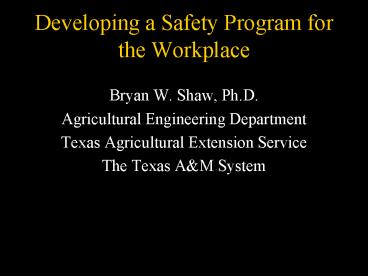Developing a Safety Program for the Workplace PowerPoint PPT Presentation
1 / 44
Title: Developing a Safety Program for the Workplace
1
Developing a Safety Program for the Workplace
- Bryan W. Shaw, Ph.D.
- Agricultural Engineering Department
- Texas Agricultural Extension Service
- The Texas AM System
2
Why Safety
3
Why Safety
- Reduce Number of Injuries
- Reduce Costs Associated with Injuries
- Comply with Regulations
4
Why Safety
5
Why Safety
- Reduce Number of Injuries
- Reduce Costs Associated with Injuries
- Comply with Regulations
6
Reduce Injury Costs
- Average cost of injury
- -11,000
- Indirect cost 50 times direct cost
- - Lost time/productivity, low morale
- - Equipment Damage
7
Costs by Injury
8
Why Safety
- Reduce Number of Injuries
- Reduce Costs Associated with Injuries
- Comply with Regulations
9
OSHA Inspections Region VI
- 4,200 /year 1/2 programmed
- Average cost 2,500 17,000
- How often once every 102 years
- Landscape 40 of violations were paperwork
violations
10
Creating a Safety Program
11
Creating a Safety Program
- Management commitment
- - Real commitment
- - Active participation
- Assignment of Authority
- - Supervisors/foremen provide lead
- - Safety committee
12
Developing a Safety Program
13
Developing a Safety Program
- Develop/implement safety policies and work rules
- - Policy should be brief, to the point and
define managements philosophy - - Clear enforceable work rules
- - Require commitment to comply
14
Safety Rules
- General
- - apply to all employees
- Job specific safety rules
- - developed specifically for each
- major job activity
15
Developing a Safety Program
- Orientation and Training
- -Orientation familiarize new
- employees with safety policy and
- work rules
- -Provide regular training refresh
16
Why Orientation is Critical
17
Developing a Safety Program
- Hazard Abatement
- - Schedule regular imspections
- - Document and correct unsafe conditions
- or practices
- - Encourage reporting of hazards
- - Develop safety procedures for new
- equipment
18
Developing a Safety Program
- Commitment to injured workers
- - Healthy employees productive
- - Let injured workers know that
- their needs are a priority
19
Developing a Safety Program
- Injury statistics and reports
- - Keep records of all injuries
- - Use to evaluate safety needs
- - Use to identify hazards to
- eliminate
20
Employee Selection
21
Employee Selection
- Develop Job Application
- Require all applicants to complete
- Verify information on application
- Use available sources to find additional
information - Complete additional checks if job requires
applicant to drive
22
Employee Selection
- Request applicants to submit to physical
examination - Request applicants to submit to drug tests
- Verify paperwork complete before offer employment
23
Employee Orientation Training
24
Employee Orientation Training
- General
- all employees
- Job Specific
- employees that perform specific task
25
Employee Orientation Training
- Keep records of topics covered
- Require employees to sign roster
- Short frequent meetings
26
Employee Orientation Training
- General All employees
- Policy and rules
- Proper lifting
- Ergonomics
27
Employee Orientation Training
- General All employees
- Policy and rules
- Proper lifting
- Ergonomics
28
Employee Orientation Training
- General All employees
- Policy and rules
- Proper lifting
- Ergonomics
29
Ergonomics
- Ergo work
- Nomos work
- Ergonomics
- Make work environment fit workers dimensions
- Rotate employees
- Working Smarter
30
Ergonomics
- Machinery is often designed
- Without considering human interface, or
- To fit the average human
- One size fits all
31
Ergonomics
- Make equipment fit within limitations and
capabilities of the worker
32
Ergonomics
- Two types of Injuries
- Instantaneous
- Cumulative Trauma Disorders (CTD)
33
Ergonomics
- Instantaneous
- Occurs as soon as the incident occurs
- Most back injuries are coded as instantaneous
34
Ergonomics
- Cumulative Trauma Disorders
- (CTD)
- Cumulative occurring gradually
- Trauma bodily injury
- Disorders Physical ailments of abnormal
conditions
35
Ergonomics
- Cumulative Trauma Disorders
- (CTD)
- Force
- Repetition
- Posture
- Lack of Rest
36
Ergonomics - Force
- Find easier way
- Use assistive devices
- Get assistance
37
Ergonomics
- Cumulative Trauma Disorders
- (CTD)
- Force
- Repetition
- Posture
- Lack of Rest
38
Ergonomics - Repetition
- Rethink task
- Alter procedure to minimize repetition
39
Ergonomics
- Cumulative Trauma Disorders
- (CTD)
- Force
- Repetition
- Posture
- Lack of Rest
40
Ergonomics - Posture
- Maintain good posture
- Modify work environment to facilitate good posture
41
Ergonomics - Posture
42
Ergonomics
- Cumulative Trauma Disorders
- (CTD)
- Force
- Repetition
- Posture
- Lack of Rest
43
Ergonomics Lack of Rest
- Consider rotating employees
- Rotation to task that stresses different muscle
tendon group
44
Employee Orientation Training
- Specific Specific employees
- Chemical Handling/PPE
- Mower Safety
- Chain Saw Safety
- Guards and Shields
- Proper Lifting, etc.

